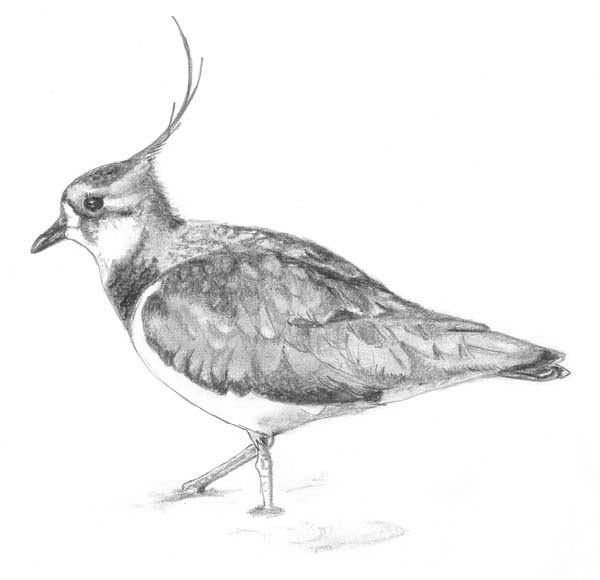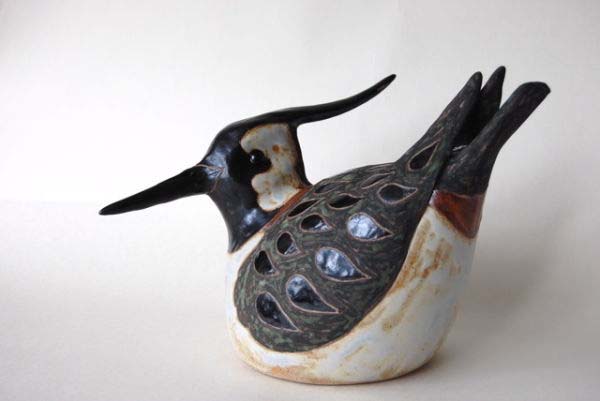Calls of “pee-wit”

My pencil sketch of a Lapwing
Its busy in the fields above my workshop – the noisy carrying-on makes me down-tools and take a few minutes to enjoy the sight and sound.

Image courtesy RSPB
Lapwings have returned – they nest in these fields and presumably they’ve come to select and compete for the best sites. Soon there will be courting displays which are wonderful to watch. Later in the year I spend time ushering the little spotty balls of fluff on wobbly long legs from the road, encouraging them to find a way back to the field through the hedge bottom. The mother bird takes flight and swoops close to my ear with hiss and alarm call and clatter of wings. The youngsters have no herding instinct whatsoever, nor do the family seem thankful.

Ceramic Lapwing sculpture by Michael Richmond
For now it gladdens my day to have them back in the landscape.

12 Comments
Oh goodness you are so lucky to have them so near! I love lapwings. How wonderful to have such contact with them and their children. I love your drawing and the sculpture too. Did you know they nest in the middle of fields to avoid the margins where predators lurk? It’s one of the reasons their numbers have fallen over the last 50 years- intensified production on farms means less land available for them to nest safely. The HLS schemes are starting to try and sort that out so it really is wonderful they can nest well with you.
So lucky, you’re right. The ones here nest mid field, in fact dotted all around. Just as the birds nest and lay eggs, the farmer ploughs up the field (currently has stubble in). I was horrified the first year it happened and went running over to the tractor to tell him about the nests. He actually had a nest with him, which he replaced in the same spot after turning the soil, and in his cab had long sticks, which he placed in the ground when he came across a nest, so he could plough round. I watch carefully, and the birds, although indignant at the time, soon settle and go back to their clutches. It was good to see the little bit they did on Countryfile about farmland birds and the work that is being done to improve the lot for Lapwings.
I spend a lot of time watching the birds. the red shouldered hawks are out flying and calling for mates.
You have such a contrast of birds Ellen, I have Buzzards flying over and calling – not sure it is for mates – they seem noisy all the time. Perhaps there is a different call, must listen really carefully next time.
Have seen good numbers of Lapwings this year, just love their call.. The drawing is lovely.
Amanda xx
Thankyou Amanda – it is good to hear you have seen lots too, it is a special call and so evocative – along with the curlew it is just the sound of the moors here.
Your drawing is wonderful. I have been trying to paint an owl’s eye (so hard – even for my less than realistic-style picture), and am full of admiration for your convincing avian eye. And yes, I always associate Lapwing with the North York Moors – but we also see them down south on coastal regions. I recall a nesting flock on Gower, when we lived in Swansea. We have a Pewet Island off Essex, which intrigues me:
Thankyou Caroline – I find painting really difficult – just keep at it, you’ll get the eye in time. I remember when I saw Lapwings at Minsmere, I thought how strange, knowing them as moorland birds, but of course they move around following the weather and food, and we also have huge winter migratory flocks here too. I wonder if the name of the island came from the bird – seems to have some association with the laughing gull?
In the Encyclopaedia Perthensis, or, Universal dictionary of the arts …, Volume 17 of 1816 lists ‘Pewet’ as a water fowl, after ‘piewit’ (Dutch). The book mentions Carew (presumably Richard?), so I don’t know if he was responsible in any way for the name or listing. Pewet Island is described as ‘an island ‘in the German Ocean, near the coast of Essex.’ It seems – from a further internet foray – that the strange spelling may be kept to distinguish this sandbank islet from Pewit Island, which is not far away … Thank you, Jennifer, for your reply – and I loved your egg post!
Yes, Caroline – I saw there was another Island Pewit – which confused me at first. I find the origins of names and words very interesting – thankyou for the details.
I see an initial ‘In’ crept in to my message above by mistake – please ignore!
I didn’t see it – too interested in all the research!